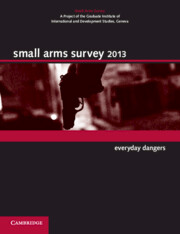Book contents
- Frontmatter
- Foreword
- Contents
- About the Small Arms Survey
- Notes to readers
- Acknowledgements
- Introduction
- Chapter 1 Everyday Dangers: Non-conflict Armed Violence
- Chapter 2 Too Close to Home: Guns and Intimate Partner Violence
- Chapter 3 Turning Points: Gang Evolution in Nicaragua
- Chapter 4 Guns in the Family: Mafia Violence in Italy
- Chapter 5 Survival at Stake: Violent Land Conflict in Africa
- Chapter 6 Trend Lines: Armed Violence in South Africa pages 132 to 137
- Chapter 6 Trend Lines: Armed Violence in South Africa pages 137 to 159
- Chapter 7 Second Wind: The PoA's 2012 Review Conference pages 160 to 168
- Chapter 7 Second Wind: The PoA's 2012 Review Conference pages 169 to 177
- Chapter 8 Trade Update: Authorized Small Arms Transfers
- Chapter 9 Burning the Bullet: Industrial Demilitarization of Ammunition pages 186 to 199
- Chapter 9 Burning the Bullet: Industrial Demilitarization of Ammunition pages 200 to 217
- Chapter 10 ‘Infernal Machines’: Improvised Explosive Devices
- Chapter 11 Price Watch: Arms and Ammunition at Illicit Markets pages 250 to 268
- Chapter 11 Price Watch: Arms and Ammunition at Illicit Markets pages 269 to 281
- Chapter 12 Captured and Counted: Illicit Weapons in Mexico and the Philippines pages 282 to 302
- Chapter 12 Captured and Counted: Illicit Weapons in Mexico and the Philippines pages 302 to 317
- Index
Chapter 10 - ‘Infernal Machines’: Improvised Explosive Devices
Published online by Cambridge University Press: 05 June 2014
- Frontmatter
- Foreword
- Contents
- About the Small Arms Survey
- Notes to readers
- Acknowledgements
- Introduction
- Chapter 1 Everyday Dangers: Non-conflict Armed Violence
- Chapter 2 Too Close to Home: Guns and Intimate Partner Violence
- Chapter 3 Turning Points: Gang Evolution in Nicaragua
- Chapter 4 Guns in the Family: Mafia Violence in Italy
- Chapter 5 Survival at Stake: Violent Land Conflict in Africa
- Chapter 6 Trend Lines: Armed Violence in South Africa pages 132 to 137
- Chapter 6 Trend Lines: Armed Violence in South Africa pages 137 to 159
- Chapter 7 Second Wind: The PoA's 2012 Review Conference pages 160 to 168
- Chapter 7 Second Wind: The PoA's 2012 Review Conference pages 169 to 177
- Chapter 8 Trade Update: Authorized Small Arms Transfers
- Chapter 9 Burning the Bullet: Industrial Demilitarization of Ammunition pages 186 to 199
- Chapter 9 Burning the Bullet: Industrial Demilitarization of Ammunition pages 200 to 217
- Chapter 10 ‘Infernal Machines’: Improvised Explosive Devices
- Chapter 11 Price Watch: Arms and Ammunition at Illicit Markets pages 250 to 268
- Chapter 11 Price Watch: Arms and Ammunition at Illicit Markets pages 269 to 281
- Chapter 12 Captured and Counted: Illicit Weapons in Mexico and the Philippines pages 282 to 302
- Chapter 12 Captured and Counted: Illicit Weapons in Mexico and the Philippines pages 302 to 317
- Index
Summary
INTRODUCTION
Shortly after 6 p.m. on 17 February 1880, Stepan Khalturin lit a fuse in the cellar of the Russian tsar's Winter Palace in St Petersburg. Around 15 minutes later, the fuse initiated 145 kg of explosives that the carpenter had smuggled into the palace on behalf of the revolutionary group, The People's Will. The resulting explosion killed and injured around 50 people, many of them servants.
The People's Will was well aware that the bombing would endanger ordinary workers—the very people the group professed to be trying to liberate—but deemed the casualties acceptable if Tsar Alexander II was killed. ‘It will kill 50 without a doubt’, said one of the plotters. ‘It is better to put in more dynamite so they don't die in vain, so it definitely gets him.’ The sacrifice was futile, though, as the Russian monarch was not in the dining hall when the bomb exploded because his guest was late for dinner (Radzinskiĭ, 2005).
This was the first mass-casualty attack carried out using high explosives and detonators, technology that had only been invented around a decade earlier by Alfred Nobel. The Swedish industrialist had devised a way to stabilize nitro-glycerine in the form of dynamite and to detonate it using small charges of less stable explosives. These technological breakthroughs had incalculable benefits for the mining and construction industries, but also put hitherto unimaginable destructive power in the hands of small groups and individuals.
- Type
- Chapter
- Information
- Small Arms Survey 2013Everyday Dangers, pp. 218 - 249Publisher: Cambridge University PressPrint publication year: 2013



